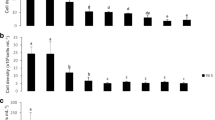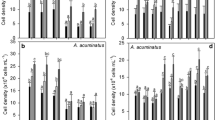Abstract
Fenoxaprop-p-ethyl (FPE) was studied for possible ecotoxicity on two representative toxigenic cyanobacteria including Microcystis aeruginosa and Microcystis viridis. Growth curves, chlorophyll a content, protein content, microcystin levels, oxidative stress, and apoptosis rates were measured for the two cyanobacteria after exposure to different concentrations of FPE. Results showed that the changes in chlorophyll a content and protein content were consistent with cell density, and M. viridis was more sensitive than M. aeruginosa to FPE. The results of oxidative stress indicated that FPE induced the generation of malondialdehyde (MDA) and enhanced the activities of antioxidant enzymes including superoxide dismutase (SOD), peroxidase (POD), and catalase (CAT) in these two cyanobacteria. To further explore the toxicity of FPE, apoptosis rates and toxin levels were measured for the two cyanobacteria. Different degrees of apoptosis rates were observed in the two cyanobacteria, and the apoptosis rates increased with the increase concentration of FPE. The intracellular and extracellular MC-LR were both affect by FPE. The presence of FPE in aquatic ecosystem may stimulate the synthesis and release of MC-LR, which may cause serious water pollution and pose threats to human health. These results may be useful for the ecotoxicity assessment of FPE and guiding the rational use of pesticides in agriculture.








Similar content being viewed by others
References
Alscher R, Erturk N, Heath L (2002) Role of superoxide dismutases (SODs) in controlling oxidative stress in plants. J Exp Bot 53:1331–1341
Arnon D (1949) Copper enzymes in isolated chloroplasts, polyphenoloxidase in Beta vulgaris. Plant Physiol 24:1–15
Beauchamp C, Fridovich I (1971) Superoxide dismutase: improved assays and an assay applicable to acrylamide gels. Anal Biochem J 44:276–287
Betancourt M, Reséndiz A, Casas E, Fierro R (2006) Effect of two insecticides and two herbicides on the porcine sperm motility patterns using computer-assisted semen analysis (CASA) in vitro. Reprod Toxicol 22:508–512
Beutler M, Wiltshire K, Meyer B, Moldaenke C, Lüring C, Meyerhöfer M, Hansen U, Dau H (2002) A fluorometric method for the differentiation of algal populations in vivo and in situ. Photosynth Res 72:39–53
Braconi D, Sotgiu M, Millucci L, Paffetti A, Tasso F, Alisi C, Martini S, Rappijoli R, Lusini P, Sprocati A, Rossi C, Santucci A (2006) Comparative analysis of the effects of locally used herbicides and their active ingredients on a wild-type wine Saccharomyces cerevisiae strain. J Agric Food Chem 54:3163–3172
Braconi D, Possenti S, Laschi M, Geminiani M, Lusini P, Bernardini G, Santucci A (2008) Oxidative damage mediated by herbicides on yeast cells. J Agric Food Chem 56:3836–3845
Bradford M (1976) Rapid and sensitive method for quantitation of microgram quantities of protein utilizing principle of protein-dye binding. Anal Biochem 72:248–254
Cevik F, Tutar M (2008) Effect of fenoxaprop-p-ethyl on natural plankton of the Seyhan dam: a microcosm study. Bull Environ Contam Toxicol 80:247–250
Chen Y, Qin B, Teubner K, Dokulil M (2003) Long-term dynamics of phytoplankton assemblages: Microcystis-domination in Lake Taihu, a large shallow lake in China. J Plankton Res 25:445–453
Cho U-H, Seo N-H (2005) Oxidative stress in Arabidopsis thaliana exposed to cadmium is due to hydrogen peroxide accumulation. Plant Sci 168:113–120
Cocker K, Moss S, Coleman J (1999) Multiple mechanisms of resistance to fenoxaprop-p-ethyl in United Kingdom and other European populations of herbicide-resistant Alopecurus myosuroides (black-grass). Pestic Biochem Physiol 65:169–180
Cummins I, Edwards R (2004) Purification and cloning of anesterase from the weed black-grass (Alopecurusmyosuroides), which bioactivates aryloxy phenoxy propionate herbicides. Plant J 39:894–904
Cuppen J, Brink PV, Woude HV, Zwaardemaker N, Broke T (1997) Sensitivity of macrophyte-dominated freshwater microcosms to chronic levels of the herbicide linuron. Ecotoxicol Environ Safety 38:25–35
Doggett S, Rhodes R (1991) Effects of a Diazinon formulation on unialgal growth rates and phytoplankton diversity. Bull Environ Contam Toxicol 47:36–42
Dowson R (1998) The toxicology of microcystins. Toxicon 36:953–962
Droge W (2002) Free radicals in the physiological control of cell function. Physiol Rev 82:47–95
EI-Dib M, Shehata S, Abou-Waly H (1991) Response of freshwater algae (Scenedeamus spp.) to phenylurea herbicides. Water Air Soil Pollut 55:295–303
Ellgehausen H, Guth J, Esser H (1980) Factors determining the bioaccumulation potential of pesticides in the individual compartments of aquatic food chains. Ecotox Environ Safe 4:134–157
Fadeel B, Orrenius S (2005) Apoptosis: a basic biologic phenomenon with wide-ranging implications in human disease. J Intern Med 258:479–517
Geoffrey A, Louise F, James S (2005) Cyanobacterial toxins: risk management for health protection. Toxicol Appl Pharmacol 203:264–272
Góth L (1991) A simple method for determination of serum catalase activity and revision of reference range. Clin Chim Acta 196:143–151
Green D, Kroemer G (2004) The pathophysiology of mitochondrial cell death. Science 305:626–629
Heath R, Parker L (1968) Photoperitation in isolated chloroplasts kinetics and stoichiometry of fatty acid peroxidation. Arch Biochem Biophys 75:189–198
Kanazawa S, Sano S, Koshiba T, Ushimaru T (2000) Changes in antioxidative enzymes in cucumber cotyledons during natural senescence: comparison with those during dark-induced senescence. Physiol Plant 109:211–216
Kearns K, Hunter M (2000) Green algal extracellular products regulate antialgal toxin production in a cyanobacterium. Environ Microbiol 2:291–297
Kirby M, Sheahan D (1994) Effects of atrazine isoproturon, and mecoprop on the macrophyte Lemna minor and the alga Scenedesmus subspicatus. Bull Environ Contam Toxicol 53:120–126
Kobraei M, White D (1996) Effects of 2, 4-dichlorohenoxyacetic acid on Kentucky algae: armukaneous laboratory and field toxicity testings. Arch Environ Contam Toxicol 31:571–580
Kwak S (1995) Acidic peroxidases from suspension-cultures of sweet potato. Phytochemistry 39(5):981–984
Leist K (1980) Toxicity test of HOE 33171 OH AT 203 in a 32-day study with SPF-mice
Lin J, Chen J, Cai X, Qiao X, Huang L, Wang D, Wang Z (2007) Evolution of toxicity upon hydrolysis of fenoxaprop-P-ethyl. J Agric Food Chem 55:7626–7629
Lorenzen C (1967) Determination of chlorophyll-a and phaeopigments: spectrophotometric equations. Limnol Oceanogr 12:343–346
Malanga G, Calmanovici G, Puntarulo S (1997) Oxidative damage to chloroplasts from Chlorella vulgaris exposed to ultraviolet-B radiation. Physiol Plant 101:455–462
Mohapatra P, Schubert H, Schiewer U (1997) Effect of dimethoate on photosynthesis and pigment fluorescence of Synechocystis sp. PCC 6803. Ecotoxicol Environ Saf 36:231–237
Mowe M, Porojan C, Abbas F, Mitrovic S, Lim R, Furey A, Yeo D (2015) Rising temperatures may increase growth rates and microcystin production in tropical Microcystis species. Harmful Algae 50:88–98
Nakai S, Inoue Y, Hosomi M, Murakami A (1999) Growth inhibition of blue-green algae by allelopathic effects of macrophytes. Water Sci Technol 39:47–53
OECD (2011) Guiding for the testing of chemicals. Freshwater alga and cyanobacteria, growth inhibition test. 201
Okmen G, Turkcan O, Erdal P (2013) Effect of herbicides on chlorophyll-a, β- caroten, phycocyanin and allophycocyanin content of Anabaena sp. J Appl Biol Sci 7:20–27
Ou H, Gao N, Wei C, Deng Y, Qiao J (2012) Immediate and long-term impacts of potassium permanganate on photosynthetic activity, survival and microcystin-LR release risk of Microcystis aeruginosa. J Hazard Mater 219:267–275
Ozair C, Moshier L (1998) Effect of soil incorporate trifluralin and selected postemergent herbicide on growth nodulation and nitrogen fixation of soybean. Pak J Agric Res 9:316–320
Pichardo S, Jos A, Zurita J, Salguero M, Camean A, Repetto G (2005) The use of the fish cell lines RTG-2 and PLHC-1 to compare the toxic effects produced by microcystins LR and RR. Toxicol in Vitro 19:865–873
Pieczenik SR, Neustadt J (2007) Mitochondrial dysfunction and molecular pathways of disease. Exp Mol Pathol 83:84–92
Pouria S, de Andrade A, Barbosa J, Cavalcanti RL, Barreto VTS, Ward CJ, Preiser W, Poon GK, Neild GH, Codd GA (1998) Fatal microcystin intoxication in haemodialysis unit in Caruaru, Brazil. Lancet 352:21–26
Rabinowitch HD, Clare DA, Crapo JD, Fridovich I (1983) Positive correlation between superoxide dismutase and resistance to paraquat toxicity in the green alga Chlorella sorokiniana. Arch Biochem Biophys 225:640–648
Ross C, Santiago-Vazquez L, Paul V (2006) Toxin release in response to oxidative stress and programmed cell death in the cyanobacterium Microcystis aerugiosa. Aquat Toxicol 78:66–73
Samson G, Popovic R (1988) Use of algal fluorescence for determination of phytotoxicity of heavy metals and pesticides as environmental pollutants. Ecotoxicol Environ Saf 16(3):272–278
Shiu C, Lee T (2005) Ultraviolet-B-induced oxidative stress and responses of the ascorbate-glutathione cycle in a marine macroalga Ulva fasciata. J Exp Bot 56:2851–2865
Song L, Hua R, Zhao Y (2005) Biodegradation of fenoxaprop-p-ethyl by bacteria isolated from sludge. J Hazard Mater 118:247–251
Sun H, Liu T, Guan Y, Liu B (2013) Physiological response to herbicides of Isoetes sinensis palmer critically endangered ferns (in Chinese). Acta Bot Boreal Occident Sin 33:1830–1837
Suzuki N, Mittler R (2006) Reactive oxygen species and temperature stresses: a delicate balance between signaling and destruction. Physiol Plant 126:45–51
Wang Y, Chen JW, Lin J, Cai XY (2009) Evolutive process and mechanism of Photoinduced toxicity of fenoxaprop-p-ethyl and 1-amino-2,4-dibromoanthraquinone. Res Environ Sci 22:843–846
Wang S, Zheng B, Chen C, Dohmann M, Kolditz O (2015) Thematic issue: water of the Erhai and Dianchi Lakes. Environ Earth Sci 74:3685–3688
Wetscher GJ, Bagchi M, Bagchi D, Perdikis G, Hinder PR, Glaser K, Hinder RA (1995) Free radical production in nicotine treated pancreatic tissue. Free Radic Biol Med 18:877–882
Wrong S, Beaver J (1980) Algal bioassays to determine toxicity of heavy metals mixtures. Hydrobiologia 74:199–208
Wu L, Qiu ZH, Zhou Y, Du YP, Liu CN, Ye J, Hu XJ (2016) Physiological effects of the herbicide glyphosate on the cyanobacterium Microcystis aeruginosa. Aquat Toxicol 178:72–79
Xu Y, Yang F, Liu Y, Wang Z, Wang J, Wang G, Li R (2011) Genetic diversity of Microcystis populations in a bloom and its relationship to the environmental factors in Qinhuai River, China. Microbiol Res 167:20–26
Ye J, Wang L, Zhang Z, Liu W (2013) Enantioselective physiological effects of the herbicide diclofop on cyanobacterium Microcystis aeruginosa. Environ Sci Technol 47:3893–3901
Ye J, Zhang Y, Chen S, Liu C, Zhu Y, Liu W (2014) Enantioselective changes in oxidative stress and toxin release in Microcystis aeruginosa exposed to chiral herbicide diclofop acid. Aquat Toxicol 146:12–19
Yun M, Yogo Y, Miura R, Yamasue Y, Fischer A (2005) Cytochrome P-450 monooxygenase activity in herbicide-resistant and -susceptible late watergrass (Echinochloa phyllopogon). Pestic Biochem and Physiol 83:107–114
Zhang D, Xie P, Chen J (2010) Effects of temperature on the stability of microcystins in muscle of fish and its consequences for food safety. Bull Environ Contam Toxicol 84:202–207
Zhang P, Zhai C, Chen R, Liu C, Xue Y, Jiang J (2012) The dynamics of the water bloom-forming Microcystis aeruginosa and its relationship with biotic and abiotic factors in Lake Taihu, China. Ecol Eng 47:274–277
Zhang J, Guo S, Guo P, Wang X (2014) The interacting effect of urea and fenoxaprop-P-ethyl on photosynthesis and chlorophyll fluorescence in Perilla frutescens. Photosynthetica 52:456–463
Acknowledgements
We appreciate Sarah S for the revision of the manuscript by language. This work was supported by the National Natural Science Foundation of China (21307082, 20977062).
Authors’ contributions
YD carried out the growth studies and drafted the manuscript. JY conceived of the study, design the study, and helped to draft the manuscript. WL carried out the MC-LR studies. CY participated in the design of the study and participated in the chlorophyll a content studies. LW performed the statistical analysis. XH participated in the protein and MC-LR studies. All authors read and approved the final manuscript.
Author information
Authors and Affiliations
Corresponding author
Ethics declarations
Competing interests
The authors declare that they have no competing interests.
Additional information
Responsible editor: Vitor Manuel Oliveira Vasconcelos
Xiaojun Hu provided some financial support to our work.
Rights and permissions
About this article
Cite this article
Du, Y., Ye, J., Wu, L. et al. Physiological effects and toxin release in Microcystis aeruginosa and Microcystis viridis exposed to herbicide fenoxaprop-p-ethyl. Environ Sci Pollut Res 24, 7752–7763 (2017). https://doi.org/10.1007/s11356-017-8474-y
Received:
Accepted:
Published:
Issue Date:
DOI: https://doi.org/10.1007/s11356-017-8474-y




